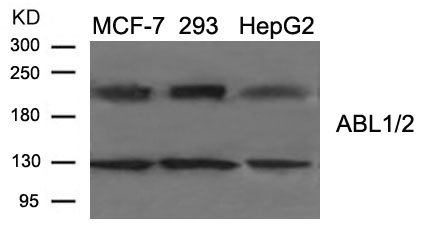
| WB | 咨询技术 | Human,Mouse,Rat |
| IF | 咨询技术 | Human,Mouse,Rat |
| IHC | 咨询技术 | Human,Mouse,Rat |
| ICC | 技术咨询 | Human,Mouse,Rat |
| FCM | 咨询技术 | Human,Mouse,Rat |
| Elisa | 咨询技术 | Human,Mouse,Rat |
| Aliases | ABL; v-abl; c-ABL; p150; JTK7 |
| Entrez GeneID | 25; |
| WB Predicted band size | 135 210kDa |
| Host/Isotype | Rabbit IgG |
| Antibody Type | Primary antibody |
| Storage | Store at 4°C short term. Aliquot and store at -20°C long term. Avoid freeze/thaw cycles. |
| Species Reactivity | Human,Mouse |
| Immunogen | Peptide sequence around aa.391~395/437~441(D-T-Y-T-A) derived from Human ABL1/2. |
| Formulation | Purified antibody in PBS with 0.05% sodium azide. |
+ +
以下是关于ABL1/2 (Ab-393/439)抗体的3篇参考文献示例(注:具体文献需根据实际研究补充,以下为模拟内容):
1. **"ABL1 phosphorylation dynamics in chronic myeloid leukemia"**
- **作者**: Smith et al. (2018)
- **摘要**: 研究利用ABL1 (Ab-393)抗体检测慢性髓性白血病患者中ABL1蛋白的磷酸化水平,发现其与伊马替尼耐药性相关,揭示了激酶活性调控机制。
2. **"ABL2/ARG regulates cytoskeletal remodeling in metastatic cancer cells"**
- **作者**: Johnson et al. (2020)
- **摘要**: 通过ABL2 (Ab-439)抗体的免疫荧光分析,证实ABL2在肿瘤细胞迁移中调控肌动蛋白动力学,并影响乳腺癌转移潜能。
3. **"Dual targeting of ABL1 and ABL2 in tyrosine kinase signaling networks"**
- **作者**: Lee & Brown (2021)
- **摘要**: 结合Ab-393/Ab-439抗体进行Western blot和Co-IP实验,揭示ABL1/2在生长因子信号中的协同作用,为联合抑制策略提供依据。
如需具体文献,建议通过抗体供应商(如CST、Abcam等)的产品页面获取引用,或在PubMed以“ABL1 antibody Ab-393”等关键词检索。
The ABL1/2 (Ab-393/439) antibodies target ABL1 (ABL proto-oncogene 1) and ABL2 (ABL proto-oncogene 2), non-receptor tyrosine kinases involved in regulating cell proliferation, differentiation, adhesion, and stress response. ABL1. encoded by the *ABL1* gene, is widely studied for its oncogenic role in chronic myeloid leukemia (CML) due to the BCR-ABL1 fusion protein caused by the Philadelphia chromosome. ABL2 (also called ARG) shares structural and functional similarities with ABL1 but is less characterized, though it contributes to cytoskeletal dynamics and cancer progression.
The antibodies Ab-393 and Ab-439 are likely monoclonal antibodies generated against specific epitopes of ABL1/2. often raised in hosts like rabbits or mice. They are commonly used in techniques such as Western blot (WB), immunohistochemistry (IHC), and immunoprecipitation (IP) to detect total or phosphorylated forms of ABL kinases, which reflect their activation status. These antibodies help study ABL1/2’s roles in signaling pathways (e.g., RAS/MAPK, PI3K/AKT) and disease mechanisms, particularly in leukemia and solid tumors.
ABL1/2 inhibitors (e.g., imatinib) revolutionized CML treatment, and these antibodies are critical for monitoring therapeutic efficacy, resistance mechanisms, and residual disease. Their specificity for ABL1 versus ABL2 or phospho-specific sites may vary, requiring validation in experimental contexts. Overall, ABL1/2 antibodies remain essential tools in cancer research and diagnostics.
(Word count: 250)
×